Physical Address
304 North Cardinal St.
Dorchester Center, MA 02124
Individuals with known or suspected velopharyngeal dysfunction (VPD) are best treated in the context of an interdisciplinary cleft/craniofacial team.
Diagnosis of VPD requires obtaining a comprehensive patient history, perceptual speech evaluation, physical examination, and appropriate instrumental and imaging studies.
Successful surgical management of VPD requires precision in diagnosis and individualization of treatment.
VPD may be the result of velopharyngeal insufficiency, velopharyngeal incompetence, or velopharyngeal mislearning.
Flexible fiberoptic nasopharyngoscopy should be completed as part of a standard preoperative evaluation to allow for direct visualization of the velopharyngeal mechanism during speech and surgical planning.
Instrumental assessment of speech should always be interpreted in the context of the results of a comprehensive perceptual speech evaluation.
Aerodynamic assessment of speech can provide the surgeon with information regarding velopharyngeal orifice size and timing to assist with treatment decision-making and judgment of surgical outcome.
The primary goal of surgical management is to produce a competent velopharyngeal mechanism for speech while avoiding the complications of nasal airway obstruction.
![]() Access video content for this chapter online at Elsevier eBooks+
Access video content for this chapter online at Elsevier eBooks+
Normal speech is dependent upon the functional and structural integrity of the velopharynx, a complex and dynamic structure that serves to decouple the oral and nasal cavities during sound production. Dysfunction of the velopharyngeal valve (referred to as VPD) may lead to hypernasality, nasal air emission, and compensatory articulation errors, all of which may impair speech intelligibility and lead to stigmatization. There may also be “non-speech” sequelae of VPD including nasal regurgitation. The goal of surgical intervention is to produce or restore velopharyngeal competence while avoiding the complications of upper airway obstruction. Successful surgical management of VPD requires precision in diagnosis and individualization of treatment. Thus, optimization of surgical outcome is critically dependent upon a careful analysis of each patient’s history, speech characteristics, structural anatomy, and velopharyngeal dynamics – an analysis best performed with close collaboration between the surgeon, the speech pathologist, and the other members of the cleft/craniofacial team.
The velopharyngeal port is defined by the soft palate, or velum, by the lateral pharyngeal walls, and by the posterior pharyngeal wall. Closure of the velopharynx during speech is a subconscious and automated action that is mediated by the motor cortex and that requires the coordinated action of the velopharyngeal musculature. The muscles of the soft palate include the levator veli palatini, the tensor veli palatini, the palatoglossus, the palatopharyngeus, and the musculus uvulae ( Fig. 21.9.1 ). The levator takes its origin from the petrous portion of the temporal bone and from the medial aspect of the eustachian tube. Its fibers course anteriorly, inferiorly, and medially, inserting into the palatal aponeurosis and decussating with the levator fibers from the opposite side ( Fig. 21.9.2 ). Contraction of the muscular sling formed by the paired levators is the primary mechanism for velar elevation and closure of the velopharyngeal port, although evidence suggests that the palatoglossus and palatopharyngeus muscles may act as antagonists to the levators to provide fine motor control of velar position during speech. The musculus uvulae is a paired intrinsic muscle that likely contributes to velopharyngeal closure both by adding bulk to the dorsal surface of the velum and by contributing to velar stretch. It is usually absent in patients with overt and submucosal clefts of the palate.
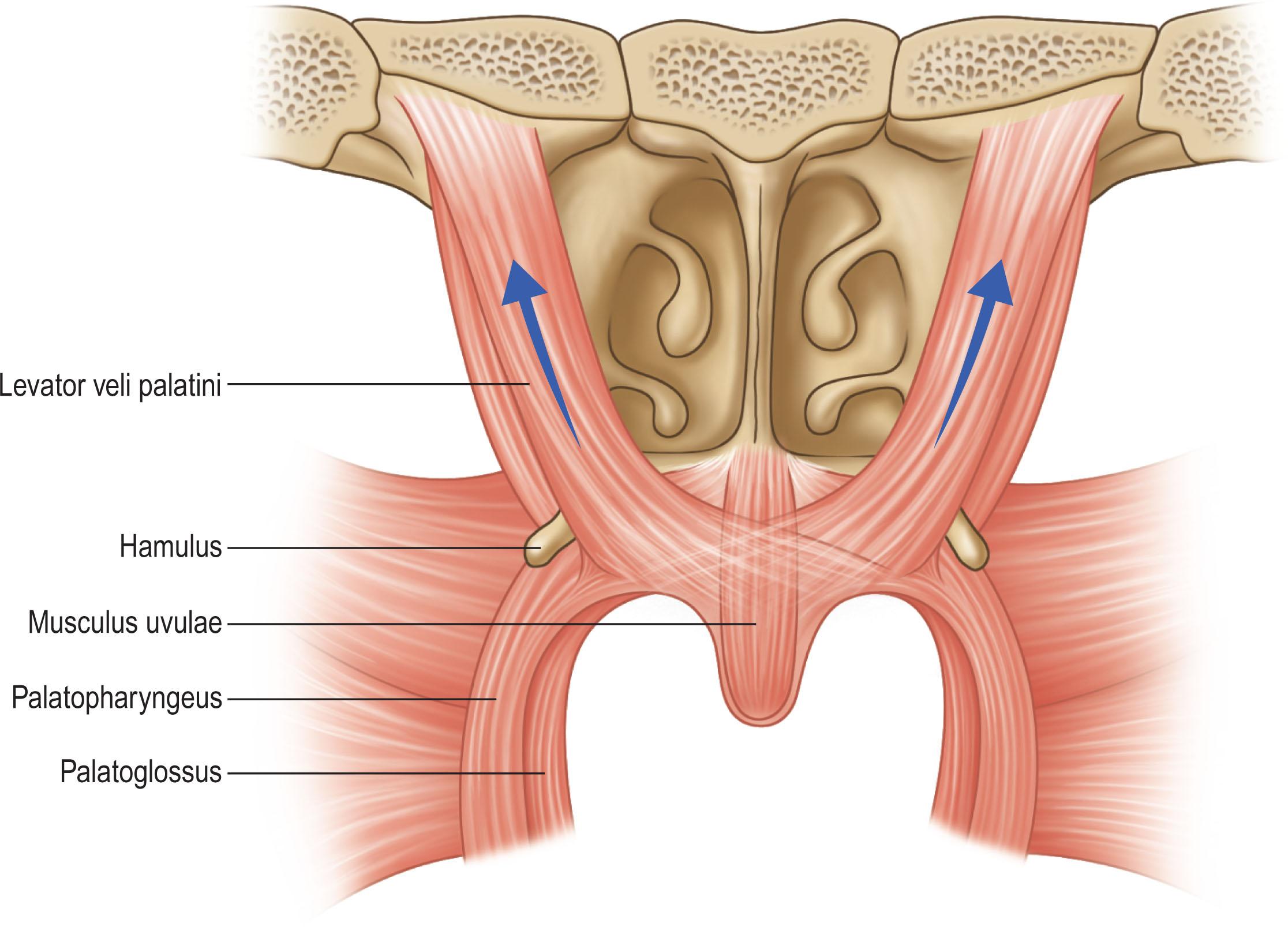
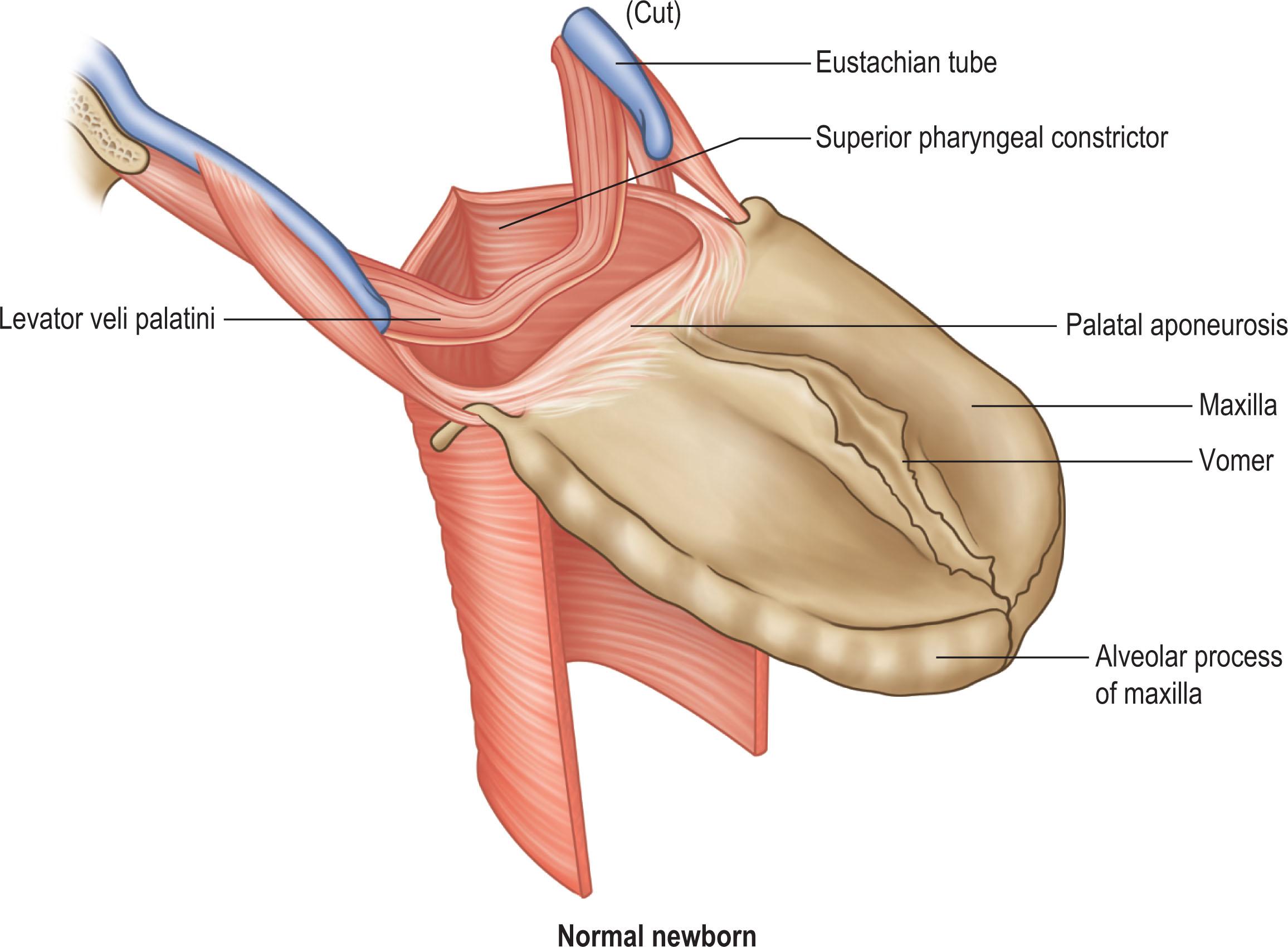
The superior pharyngeal constrictor is a broad, thin muscle that takes origin from the velum, the medial pterygoid, and the pterygomandibular raphe, inserting into the median pharyngeal raphe along with the constrictor muscle fibers from the opposite side. Contraction of the superior constrictor may contribute to velopharyngeal closure by effecting medial movement of the lateral walls and anterior movement of the posterior wall of the velopharynx. The anatomy of the superior constrictor and its contribution to velopharyngeal closure, however, are highly variable.
With the exception of the tensor veli palatini, which is innervated by the third division of the trigeminal nerve (V 3 ), all of the muscles of the velopharynx receive motor innervation from the pharyngeal plexus, which is composed of fibers from the glossopharyngeal (IX), vagus (X), and accessory (XI) nerves. Studies have suggested that the facial nerve (VII) may also play a minor role in velopharyngeal motor function. It is important to note that, although the functional activity of the velopharyngeal valve during speech and swallowing may be similar, the neurological pathways for these activities are distinct. Velopharyngeal movements for speech are learned, automatized activities that are controlled by the motor cortex, whereas similar movements for swallowing are primarily involuntary activities that originate from the brainstem.
The velopharynx is a complex, three-dimensional valve which serves to uncouple the oropharynx and nasopharynx during speech and swallowing. This section briefly discusses velopharyngeal function during speech.
It is widely accepted that the levator veli palatini is the muscle that is primarily responsible for velar motion and, hence, for velopharyngeal closure. Fine motor control of velar position may also be governed by the palatoglossus and palatopharyngeus. As noted above, the paired musculus uvulae may play an important role in velar stretch and in filling the gap between the velum and the posterior pharynx during velopharyngeal closure. The relative contribution of the levator and of the superior pharyngeal constrictor to lateral pharyngeal wall movement has been the subject of some debate.
In normal individuals, the velum lifts posteriorly and superiorly during velopharyngeal closure. The normal point of contact with the posterior pharyngeal wall is located approximately three-quarters of the way back on the velum from the posterior nasal spine ( Fig. 21.9.3 ). The site of velopharyngeal closure is usually at or just inferior to the palatal plane which is typically at or above the level of the first cervical vertebrae (C1), but velar height, as well as the extent of velopharyngeal contact, varies systematically depending upon the phonetic context, speech accuracy, rate, and effort.
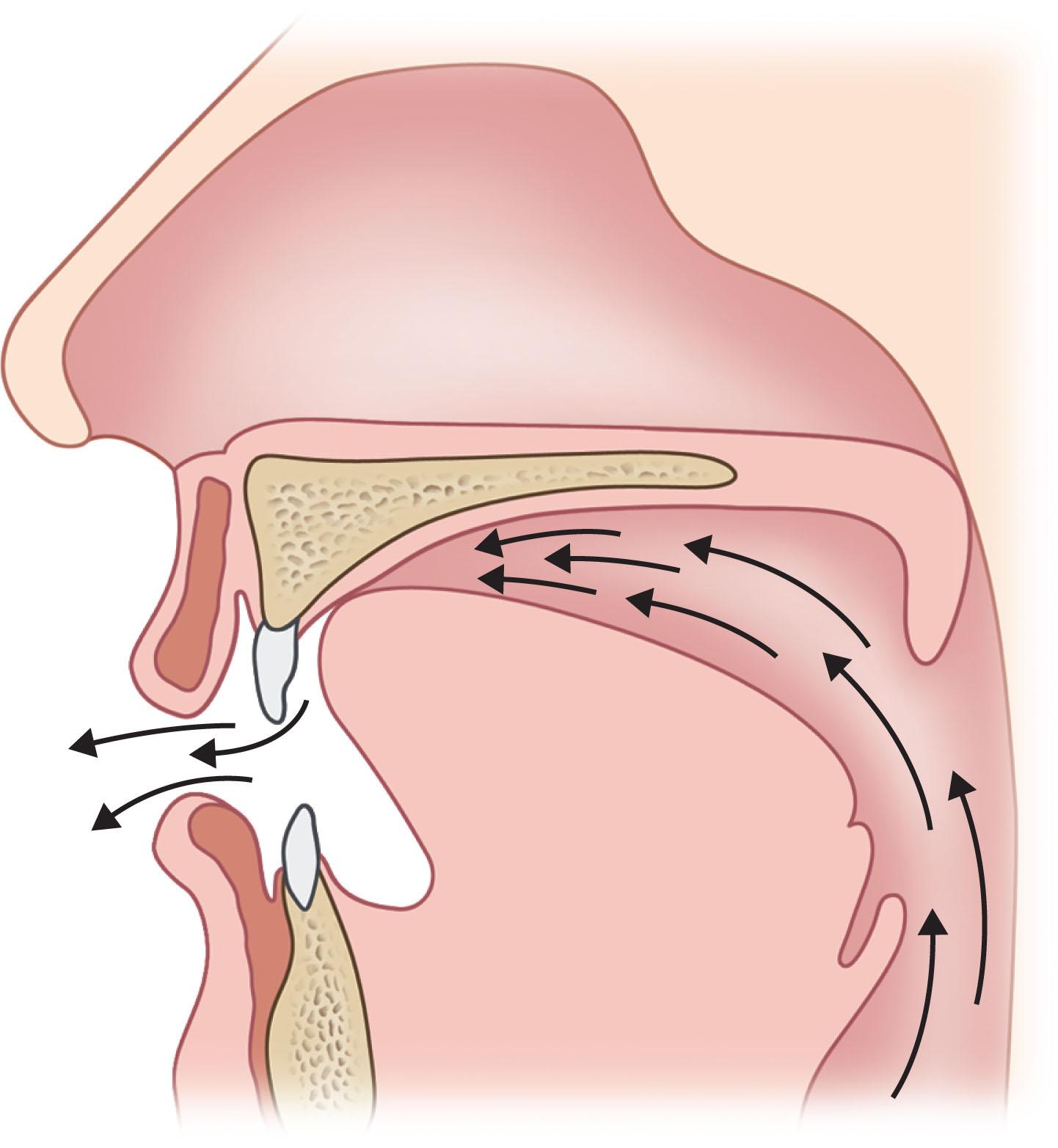
The contribution of lateral pharyngeal wall movement to velopharyngeal closure varies amongst individuals with or without cleft palate and, as with velar movement, varies with the phonemic task. Maximal lateral pharyngeal wall displacement generally occurs at the level of velopharyngeal contact. Skolnick et al . and Croft et al . have described three basic patterns of velopharyngeal closure observed in normal subjects ( Fig. 21.9.4 ): (1) coronal, in which closure is effected primarily by velar elevation; (2) circular (with or without Passavant’s ridge), in which medial movement of the lateral pharyngeal walls contributes to velopharyngeal closure in near-equal proportion to the velum; and (3) sagittal, in which closure is effected primarily by medial movement of the lateral pharyngeal walls and the velum contacts the lateral walls rather than the posterior wall. Of these, the coronal pattern of closure is observed most commonly in both normal individuals and in patients with VPD. In some individuals, a localized transverse ridge of tissue may be seen to form on the posterior pharyngeal wall during speech. This anterior movement of the posterior pharyngeal wall during velopharyngeal closure was first described by Passavant in 1863 and is therefore frequently referred to as “Passavant’s ridge”. Although some have written that its appearance is always indicative of pathologic velopharyngeal function, Croft et al . have demonstrated that Passavant’s ridge may play a role in velopharyngeal closure in both normal speakers and in those with VPD.
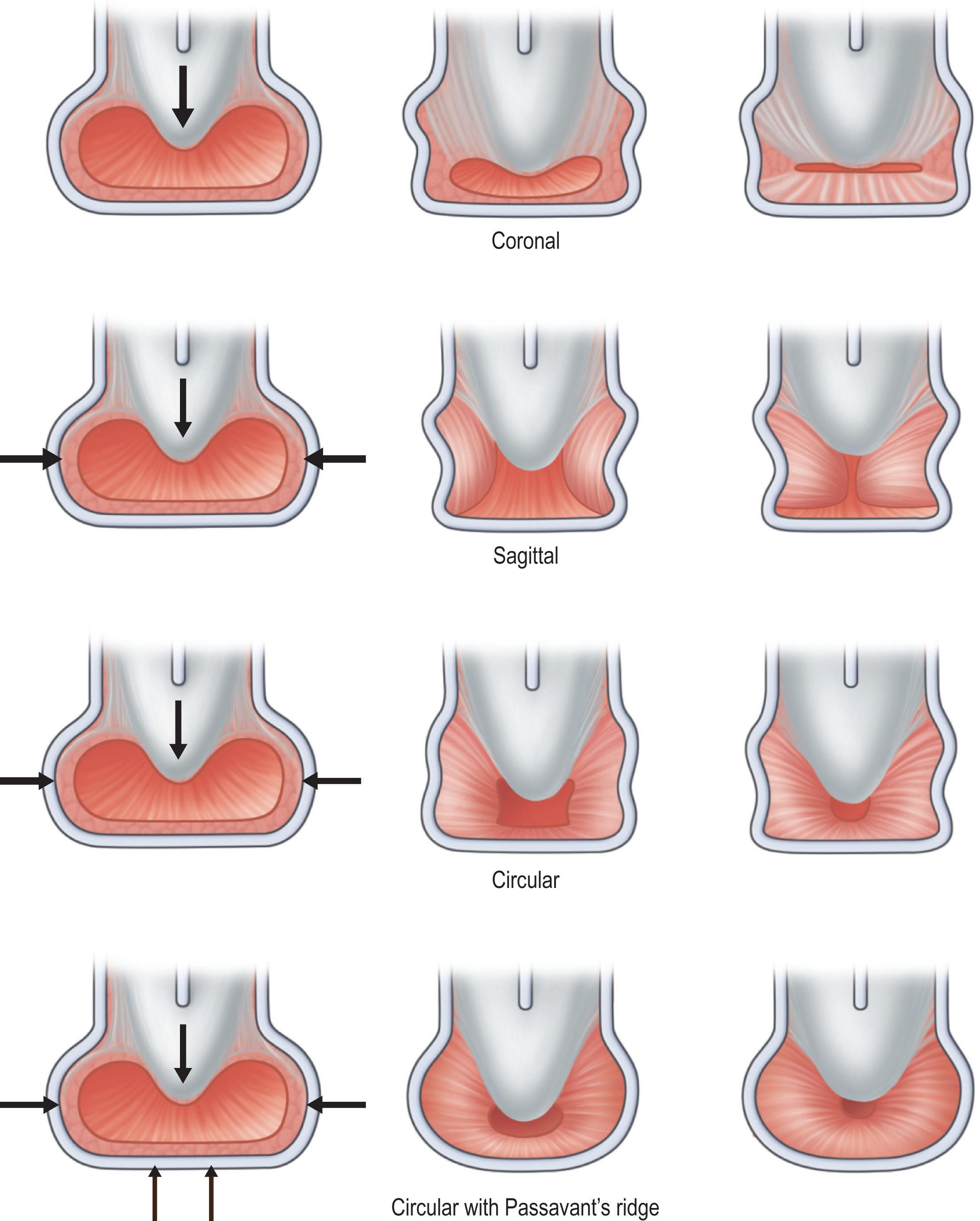
Electromyographic studies support the notion that normal velopharyngeal function requires the central coordination of velopharyngeal muscle activity with other articulatory movements. Changes in velar position during sound production represent the end result of a complex interaction of several interrelated variables, including auditory and proprioceptive feedback. Moreover, for a single individual, there may be significant flexibility in the system of sound production such that there may be a limited but variable repertoire of velopharyngeal movements that may produce the same perceived sounds. Despite decades of speech science research, the precise neurophysiology of both normal and abnormal velopharyngeal function remains incompletely understood.
MRI has quickly gained ground as the primary method for studying the anatomy and emerging physiologic measures of velopharyngeal structures, but it has not yet been shown to be as accurate or reliable in estimating velopharyngeal closure pattern as nasopharyngoscopy. Perry et al . and Bae et al . have shown the application of both traditional and 3D MRI for evaluation of velopharyngeal anatomy in persons with and without clefts. MRI has also been utilized to explore sexual dimorphism in velopharyngeal structures as well as how velopharyngeal anatomy and physiology changes over time with growth and aging. Lastly, dynamic MRI during speech is now feasible in the clinical setting as a complementary tool for clinical evaluation of VP function for speech.
The first major diagnostic category of VPD is velopharyngeal insufficiency, a term used to denote an anatomic, or structural, defect responsible for inadequate closure of the velopharyngeal valve. Such defects may be congenital, as in cases of cleft palate or congenital velopharyngeal disproportion (i.e., a short soft palate relative to the depth of the pharynx) ( Fig. 21.9.5 ), or they may be secondary to surgical procedures that alter velopharyngeal anatomy, as in cases of palatoplasty, tumor resection, or adenoidectomy. The most common congenital structural defects associated with VPD are cleft palate and submucosal cleft palate. The reported incidence of persistent VPD after cleft palate repair varies widely and is influenced by a large number of variables. In a recent report of long-term outcomes following Furlow palatoplasty, secondary surgery for VPD was only clinically indicated in 8% of children at five years of age. In the absence of an oronasal fistula, however, VPD after palatoplasty is most commonly the result of impaired velar mobility, velopharyngeal disproportion, or a combination of both.
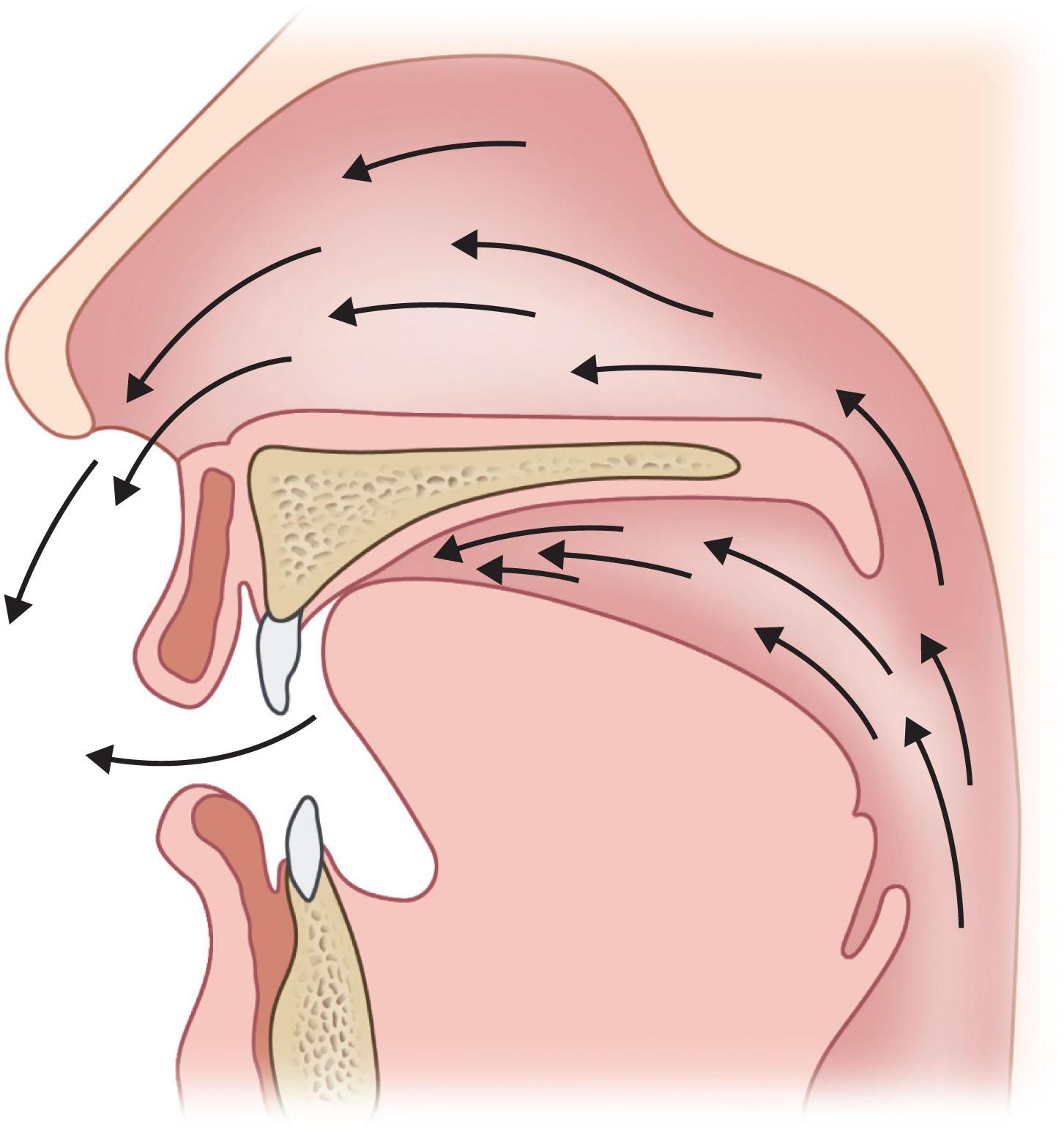
Since adequacy of velopharyngeal closure is largely a function of the ratio of pharyngeal depth to palatal length, patients with a proportionally short palate or deep pharynx may demonstrate incomplete velopharyngeal closure (see Fig. 21.9.5 ). Each of these conditions may be the result of either a congenital anomaly or an iatrogenic alteration in velopharyngeal architecture. Cicatricial changes following palatoplasty, for example, may lead to velopharyngeal insufficiency secondary to velar shortening. Congenital differences in skeletal architecture may also play a role in postpalatoplasty VPD. Patients with clefts have been demonstrated to have a broader nasopharynx than controls, likely the result of alterations in cranial base dimensions. Osborne et al . and Ross and Lindsay have shown that a higher prevalence of upper cervical spine abnormalities in patients with clefts may result in increased pharyngeal depth. Likewise, platybasia, or flattening of the cranial base angle, may contribute to VPD by increasing pharyngeal depth, and thus the depth-to-length ratio. Ruotolo et al . have shown that patients with 22q11.2 deletion syndrome, a condition associated with a high frequency of severe non-cleft VPD, demonstrate several predisposing skeletal and soft-tissue anomalies, including increased pharyngeal depth, platybasia, and cervical spine anomalies. Furthermore, Haenssler et al . found that cerebellum volume was significantly reduced and cranial base angles were significantly more obtuse in individuals with 22q11.2 deletion syndrome. A recent study by Kolarra et al . corroborated this evidence, adding that patients in their study with 22q11.2 deletion syndrome demonstrated a thinner velum and a shorter levator veli palatini muscle with a greater angle of origin.
Velopharyngeal insufficiency may also be caused by postsurgical changes in velopharyngeal anatomy. In young children, velopharyngeal closure is most often velar–adenoidal. Removal of hyperplastic adenoids for the management of nasopharyngeal airway obstruction or chronic otitis media results in an acute increase in pharyngeal depth. In the majority of non-cleft patients, the capacity for velar stretch allows the palate to accommodate for this change. In most cases, postadenoidectomy velopharyngeal insufficiency is transient, and resonance returns to normal within 6–12 months. VPD may persist, however, in a small number of patients, some of whom may have predisposing factors for VPD, including submucosal cleft palate, a short velum, a deep pharynx, or neuromuscular disorders. For patients with these conditions, the adenoids may play a critical role in velopharyngeal closure, and even their normal involution may result in velopharyngeal insufficiency. Careful assessment of velopharyngeal anatomy is therefore essential in all patients prior to adenoidectomy and should be avoided if possible when anatomical factors that predispose to VPD are identified.
In some patients, irregularity of the surface contour of the adenoid pad may interfere with the ability of the velum to achieve complete velopharyngeal closure. In others, enlarged tonsils may intrude between the velum and the posterior pharyngeal wall, resulting in incomplete closure. In these cases, the first step in management should be a selective adenoidectomy or tonsillectomy, respectively, as such may be sufficient to solve the problem, obviating the need for any of the surgical procedures later described.
The second major diagnostic category of VPD is velopharyngeal incompetence. This label is typically reserved for those cases of VPD known or suspected to be due to congenital or acquired neurological and/or neuromuscular causes such as cerebrovascular incidents, traumatic brain injury, brain tumor, abnormalities in muscle tone or function, and degenerative neuromuscular diseases. In velopharyngeal incompetence, there is typically no evidence of any underlying structural abnormality and palatal length is sufficient; however, the function of the velopharyngeal mechanism is suboptimal for speech production and/or swallowing. The speech sequelae of velopharyngeal incompetence are similar to that seen with velopharyngeal insufficiency, except that many of the individuals also demonstrate other features of dysarthria or other motor speech impairments (e.g., apraxia). Abnormal innervation of cranial nerves IX, X, or XI, or abnormalities in muscle tone/function may result in abnormal timing of palatal elevation which may also exacerbate the perception of hypernasal speech, in excess of that predicted by velopharyngeal gap size alone. In addition, adults with velopharyngeal incompetence, depending on the etiology, frequently exhibit dysphagia and varying degrees of nasal regurgitation.
There are extensive possibilities for neurologic diagnoses that may be associated with congenital velopharyngeal incompetence including, but not limited to, cerebral palsy, myotonic dystrophy, and congenital hypotonia. Asymmetrical velopharyngeal function, such as that typical of patients with hemifacial microsomia, is also a common cause of velopharyngeal incompetency. Acquired or “late” causes of velopharyngeal incompetence may include traumatic brain injury; cerebrovascular accident or brainstem stroke; and progressive diseases such as Parkinson’s disease, amyotrophic lateral sclerosis, muscular dystrophies, multiple sclerosis, and other demyelinating diseases.
Children and adults with motor speech disorders have also been shown to demonstrate symptoms of velopharyngeal incompetence of varying degrees of severity and consistency. Apraxia of speech (also referred to as developmental apraxia of speech or childhood apraxia of speech, in children) is a neurologic condition resulting in difficulties with speech motor programming and control. Apraxia may be characterized by inconsistent symptoms of VPD such as inconsistent nasalization of vowels or consonants and inconsistent nasal emission. In addition, many individuals with apraxia may exhibit a combination of both inconsistent hypernasality and hyponasality, providing additional evidence of the abnormal coordination of the palate during speech sound production. Younger children with apraxia may demonstrate some overlapping speech features often seen in children with congenital velopharyngeal incompetence of other causes. For example, children with a history of VPD may have a limited inventory of sounds and demonstrate difficulties learning to produce oral consonants in the first few years of life. These children may produce a pattern of compensatory articulation errors (i.e., glottal stop substitutions) or omit sounds completely. Children with apraxia have difficulty with generating the appropriate “motor program” (blueprint) for producing the sequence of motor movements to produce a sound, which is not typical of children with isolated VPD or clefting. The importance of obtaining a thorough speech pathology evaluation to diagnose these conditions differentially is critical for appropriate treatment decision-making.
Lastly, stress velopharyngeal incompetence is a special case of velopharyngeal incompetence for non-speech behaviors. It is most commonly observed in wind musicians given the high pressure demands. There may or may not be comorbid hypernasality or nasal emission in speech. In some cases, stress velopharyngeal incompetence may be an indicator of an underlying physical cause of velopharyngeal incompetence, which may have been masked, or very mild, in the past. In some cases, neurologic or structural causes of VPD (e.g., submucous cleft palate) are diagnosed following the presentation of stress velopharyngeal incompetence, further emphasizing the importance of a thorough clinical evaluation of all patients with any form of VPD. Treatment for stress velopharyngeal incompetence may follow a similar course as that for VPD for speech, although there have been reported cases of spontaneous recovery after a period of rest.
The third, and lesser known, type of VPD involves velopharyngeal mislearning. In this category, the velopharyngeal mechanism appears to be anatomically and physiologically capable of consistent and complete velopharyngeal closure for speech, despite the observation of inconsistent velopharyngeal closure for speech. In this type of VPD, the patient has mislearned how to produce certain speech sounds accurately. The most common example is that of phoneme-specific nasal emission, in which nasal airflow is produced as a complete substitution for an oral consonant, despite adequate velopharyngeal closure ability for other consonants. Clinically, this will often be observed in a child with nasal emission heard on a selected set of sounds, most commonly S, Z, SH, or CH, but not on other sounds such as P, B, T, D, K, G. Another example of velopharyngeal mislearning is the case in which a child produces compensatory articulation errors (e.g., glottal stops) which may prevent or interfere with the achievement of adequate velopharyngeal closure for speech. The velopharyngeal movements during the production of these aberrant speech errors have been shown to be counterproductive (distal versus medial movement of the lateral pharyngeal walls) to the achievement of velopharyngeal closure for speech. A related example is that seen in children with congenital hearing loss with an inability to self-monitor their own speech production, resulting in nasalized speech errors with an otherwise physiologically intact velopharyngeal mechanism.
Velopharyngeal mislearning should be treated with behavioral speech therapy, not surgery. It is critical that a well-trained speech pathologist perform a thorough clinical evaluation to diagnose such conditions differentially in order to make the most appropriate treatment recommendations.
In some cases, individuals with craniofacial anomalies and/or clefting may exhibit a combined disorder with evidence of velopharyngeal insufficiency, velopharyngeal incompetency, and/or velopharyngeal mislearning, which poses a diagnostic challenge. Some patients with 22q11.2 deletion syndrome have been shown to demonstrate evidence of a combined type of VPD due to the combination of structural clefting disorders, increased pharyngeal depth, and hypotonia of the velopharynx. Regardless of the type of VPD which is present, a complete and thorough physical exam, clinical speech evaluation, and any necessary instrumental or imaging studies should be completed to confirm the etiology and identify the most appropriate treatment plan.
Become a Clinical Tree membership for Full access and enjoy Unlimited articles
If you are a member. Log in here